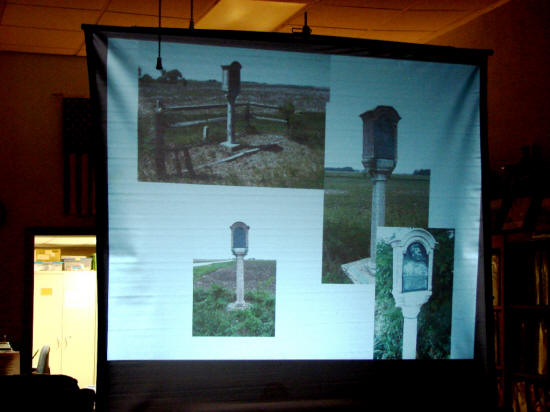|
 Chuck likes to delve into the places, events,
and people that make up the fascinating history of central Illinois,
and spread the word. In this case, he brought the little known
history of the Daughters of the American Revolution (DAR) program
from the 1920’s to mark the route of the Eighth Judicial Circuit
with monuments. Chuck likes to delve into the places, events,
and people that make up the fascinating history of central Illinois,
and spread the word. In this case, he brought the little known
history of the Daughters of the American Revolution (DAR) program
from the 1920’s to mark the route of the Eighth Judicial Circuit
with monuments.
This story starts in 2007 and then travels back to the 1840’s. “I
would never have known about this event if I had not met Guy Fraker,”
said Chuck. Guy Fraker is a lawyer, historian, and author who lives
in Bloomington. His focus has always been on Abraham Lincoln, and
how Illinois shaped our most beloved President.
Abraham Lincoln was a successful lawyer in Illinois, and as part of
his practice traveled the Eighth Judicial Circuit bringing the law
to areas that had no legal access.
The Eighth Circuit was a circuitous route that went to county seats
from Springfield to the Peoria area then to Bloomington and
Danville. The Eighth stopped at the Postville Courthouse in Lincoln
when the town was the first county seat of Logan County. It then
wended its way south to Taylorville and Shelbyville before returning
to Springfield.
The lawyers who traveled along with Mr. Lincoln formed a community
who not only represented people needing legal representation, but
also acted as prosecutors and judges. “The travelers on the Eighth
spent up to four months and traveled four-hundred miles to cover
what would otherwise have been a legal desert,” said Chuck McCue.
Initially, the lawyers and Mr. Lincoln actually did ride horses
around the circuit, but later on some county seats were accessible
by train.
It is no exaggeration that Mr. Lincoln’s time on the Eighth was
instrumental to his successful career as a lawyer, and his later
climb to the top of the political ladder.
In 1923, the DAR decided on a plan to memorialize the Eighth with
monuments that would be placed at every county courthouse where Mr.
Lincoln practiced law, and every location where it crossed a county
line.

It was an ambitious project. Think about the logistics. Since Mr.
Lincoln’s time on the circuit, county lines had changed, counties
were added, county seats moved, and new roads were built and old
roads were abandoned. All of this, and funding the project, but they
got it done. The DAR talked the counties into funding the project
within their jurisdiction, hired an artist who worked on the Lincoln
Memorial in Washington D.C. to design the monuments, and even
interviewed in 1919 the last surviving lawyer who rode the Eighth
with Mr. Lincoln in the late 1850’s.

A marker that still remains along the Eighth Judicial Circuit Route.
Where are these monuments today? Well, some of them
still exist, mostly at the location of a county seat courthouse.
Many courthouses have been torn down since the 1920’s, but some of
the monuments still exist.
[to top of second column] |

The monuments at county lines are more problematic.
Roads have been abandoned, but some monuments still exist in the
middle of nowhere, while some still stand on a road that sees little
if any use. Many of the monuments that still exist are in poor
condition, while some are missing altogether. “One may be at the
bottom of Lake Shelbyville,” said Chuck McCue.

A few of the monuments still remain. They could be along a lonely
country road that sees little traffic, or a busy highway.


A farm family saved the plaque from a damaged marker, and built one
of their own design near the original location.
In the original plan, Logan County had five of the
monuments.
There is a plan to repair as many of the monuments as possible. A
concrete expert from Iowa has been engaged by the DAR to assist in
restoration of a few of them.
Chuck has created a map with the location of the remaining monuments
with their GPS coordinates.
Today, there are wine trails, craft brewery trails, and bourbon
trails, but from a time gone by, there was an Eighth Judicial
Circuit Trail that recorded the movements of one of the greatest of
Americans. Abraham Lincoln grew in stature as he traveled the
Eighth, and then saved the ‘United’ States.
The Logan County Genealogical and Historical Society meets on the
third Monday of the month at 6:30 p.m. at their research facility on
Chicago Street. They always have an interesting speaker and the
public is invited.
[Curtis Fox]
 |